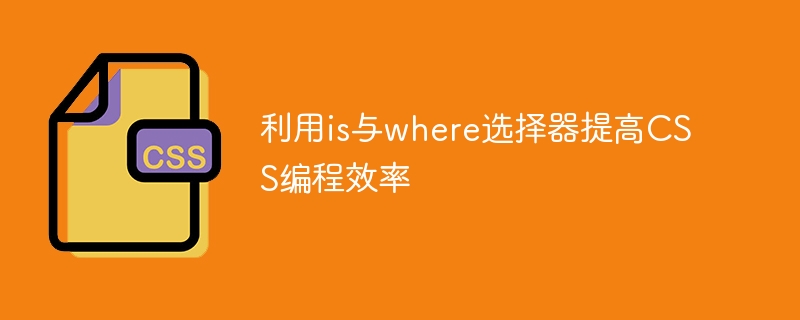

With the development of Internet technology, web design has become an important field. CSS (Cascading Style Sheets), as a web page style definition language, is widely used in web design. As the complexity of web pages continues to increase, writing efficient CSS code becomes crucial. This article will focus on how to use is and where selectors to improve CSS programming efficiency.
First, let’s understand the is selector. The is selector is a new selector introduced in CSS Level 4. It can match multiple selectors on one element at the same time, simplifying the writing of CSS code. Using the is selector, we can classify multiple elements with the same style attributes into the same selector, thereby improving the readability and maintainability of the code. For example, if we want to set the elements with class "header" and "footer" to the same background color, the traditional way of writing requires writing two selectors respectively:
.header {
background-color: #f2f2f2;
}
.footer {
background-color: #f2f2f2;
}and using the is selector, We can simplify them into a selector:
.header, .footer {
background-color: #f2f2f2;
}This not only reduces the amount of code, but also improves the readability of the code.
Secondly, let’s introduce the where selector. The where selector is another new selector in CSS Level 4. It finds the first matching selector in a list of selectors and applies its corresponding style attributes. This is useful when working with elements that have multiple style attributes. For example, if we have an element with different classes, each class corresponding to a different style attribute, we can use the where selector to simplify the code. For example:
div.replaceable-class {
color: red;
}
p.replaceable-class {
color: blue;
}
span.replaceable-class {
color: green;
}
/* 使用where选择器 */
.where(|div, p, span|).replaceable-class {
color: var(--my-color);
}In the above code, all elements with class "replaceable-class" will have the same color applied. Using the where selector, we can summarize different selectors with the same style attributes into one selector, thus simplifying the code structure.
In addition to the is and where selectors, there are some other selectors that can help improve the efficiency of CSS programming. For example, use the :not selector to select elements other than a specific element. Use the :has selector to select parent elements that contain a specific element. Use the :lang selector to select elements based on the document's language attributes. All these selectors help simplify CSS code and improve development efficiency.
When writing CSS code, you need to choose the appropriate selector according to the specific situation to improve programming efficiency. Use the new CSS Level 4 selectors whenever possible to reduce the amount of code and improve the readability and maintainability of the code. In addition, the rational use of CSS pre-compilation tools, modular development and code optimization techniques is also the key to improving CSS programming efficiency.
In short, using the is and where selectors is an important method to improve the efficiency of CSS programming. They can simplify code structure and improve code readability and maintainability. In actual development, we should flexibly use various selectors and combine them with other development techniques to improve CSS programming efficiency and provide users with a better web page experience.
The above is the detailed content of Use is and where selectors to improve CSS programming efficiency. For more information, please follow other related articles on the PHP Chinese website!
 What to do if win8wifi connection is not available
What to do if win8wifi connection is not available
 Comparative analysis of iqooneo8 and iqooneo9
Comparative analysis of iqooneo8 and iqooneo9
 How to use fit function in Python
How to use fit function in Python
 Solid state drive data recovery
Solid state drive data recovery
 Change word background color to white
Change word background color to white
 Google earth cannot connect to the server solution
Google earth cannot connect to the server solution
 What are the reasons why a mobile phone has an empty number?
What are the reasons why a mobile phone has an empty number?
 css beyond display...
css beyond display...




